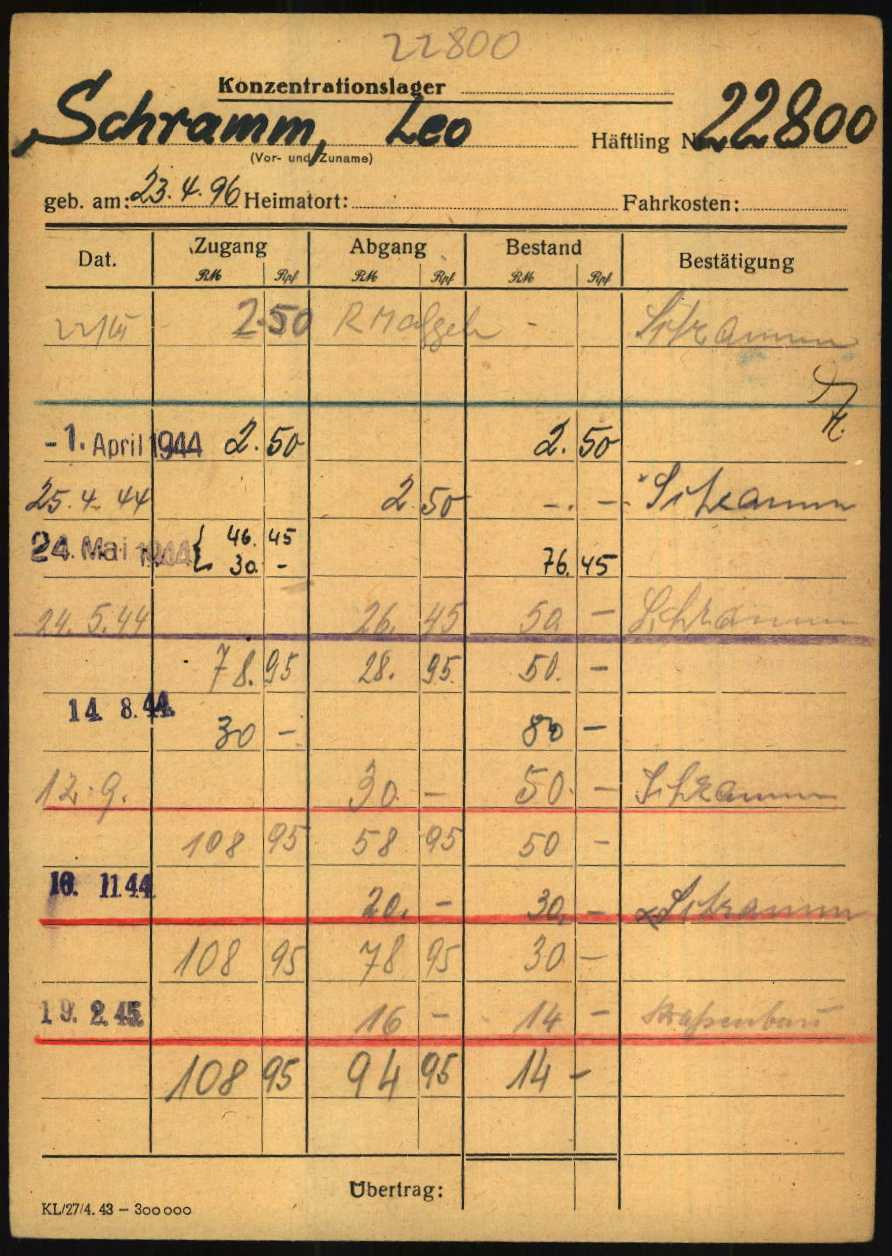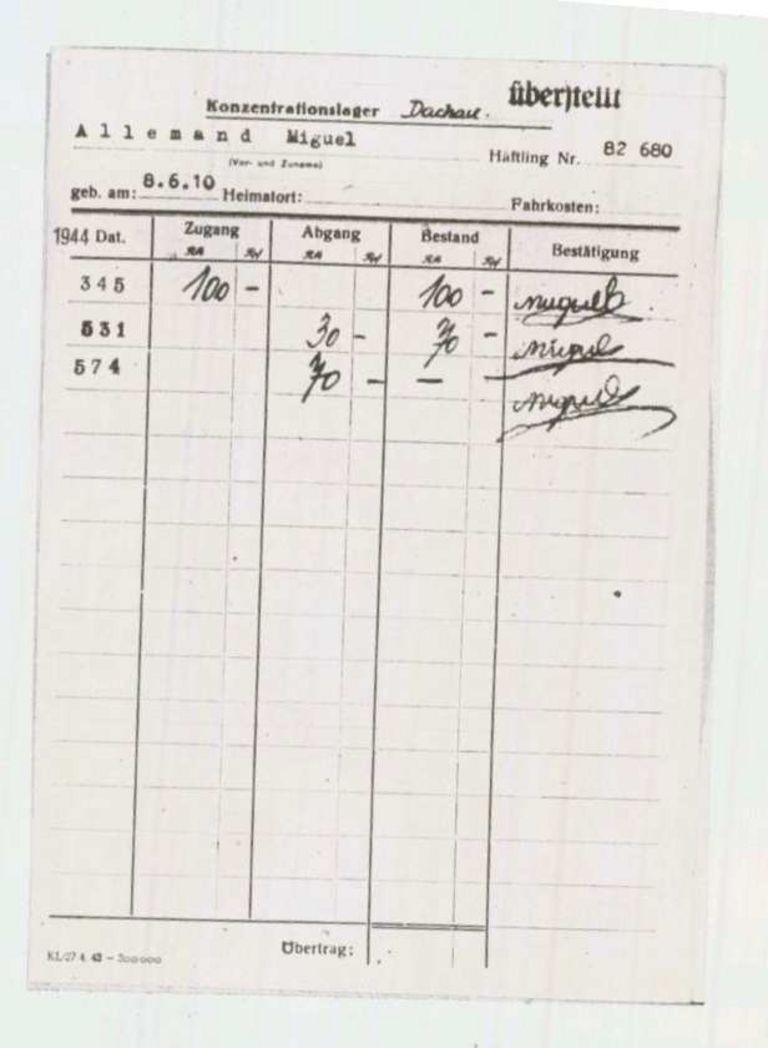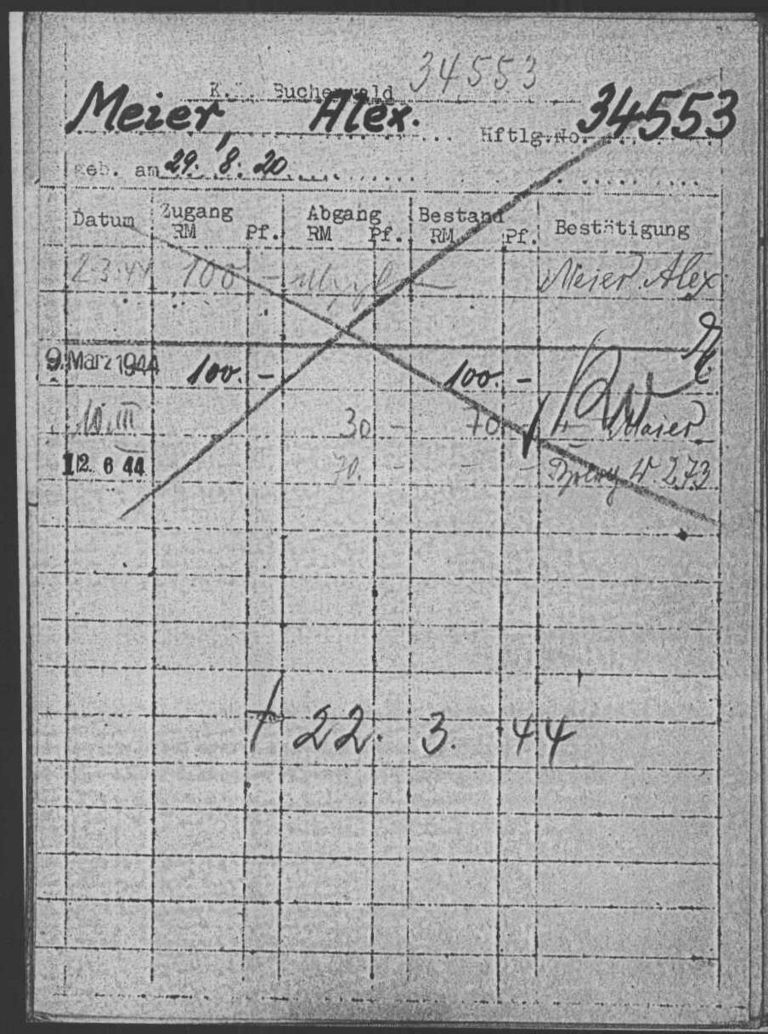Page of
Page/
- Reference
- Intro


Money account cards, as they are officially known, were kept on file in the main camps. The cards can have different amounts of information depending on whether money was sent to a prisoner or not. But the cards from different camps and time periods are basically very similar. Money account cards can be identified by their tabular structure.
Money account cards, as they are officially known, were kept on file in the main camps. The cards can have different amounts of information depending on whether money was sent to a prisoner or not. But the cards from different camps and time periods are basically very similar. Money account cards can be identified by their tabular structure.
Questions and answers
-
Where was the document used and who created it?
The personal effects storage room was not only responsible for managing the prisoners’ clothing but also for storing their money. There were three official ways for prisoners to have money in the concentration camps: They might have money with them when they arrived at the camp, which they would then have to hand over; they could receive a postal money order from their families; or, from May 1943, bonuses were paid to selected prisoners as a work incentive.
In the prisoner funds administration office (Häftlingsgeldverwaltung) – a sub-unit of the personal effects storage room – SS men and female SS guards handled incoming and outgoing payments. According to a regulation from 1940, no prisoner functionaries were supposed to work in this part of the camp. However, there was a small group of prisoner functionaries responsible for managing the money account cards, at least in Dachau.
Prisoners had to confirm incoming and outgoing payments by signing their money account cards. If a prisoner was transferred from another camp and money arrived from this previous camp, this was also noted on the card. The card file was alphabetically ordered and kept in the prisoner funds administration office. Unlike other documents, such as the Prisoner Registration Card, there is little variation in the color of the paper used for money account cards (with the exception of one orange version).
- When was the document used?
Money account cards were used very early on in the concentration camps. For example, cards have been preserved from Buchenwald from 1937, when the camp was still referred to as the Ettersberg concentration camp. Money account cards had also been used prior to this in the Esterwegen concentration camp, which closed in 1936. As with the personal effects cards, the money account cards used by the SS were based on a system that had been common in German prisons even before 1933.
The early cards already resembled the standardized blank forms that were later produced in the Auschwitz camp printing office and distributed to the various concentration camps. These standardized cards, which were printed from around 1942 onwards, can be identified by the document identification number at the lower left edge. The abbreviation KL/ is followed by a number as well as the month and year of printing. The blank forms were regularly updated and given a new order number. Up to 300,000 copies of the money account card were printed in one run.
- What was the document used for?
In an order from the Concentration Camps Inspectorate from June 1940, the precise use of the money account cards was stipulated: “Every incoming payment is to be noted on this file card, and its accuracy is to be confirmed by the account holder. In the case of outgoing payments, the rightful recipient must also confirm receipt of the amount on this file card. […] If the recipient is illiterate, he must acknowledge the receipt with three x’s, and this signature is to be certified by two impartial witnesses.”
The amount of money a prisoner was allowed to receive in the camp depended on his or her nationality. German prisoners could receive unlimited funds, while non-German prisoners were allowed to receive 15 Reichsmarks twice a month. The money could be withdrawn on specific days every two to four weeks. Each block would have to submit a money request in advance so that the prisoner funds administration office could order the necessary funds from a local bank or savings bank. Here, too, there were different rules for how much a prisoner could withdraw. Sometimes the funds were issued as so-called “camp money,” a currency that could only be used in the camp and was supposed to make it harder to escape. As a punishment, prisoners could also be barred from receiving money.
In the camps, money could be used in the canteen to purchase tobacco and food, among other things, or it could be exchanged for food on the black market. For a long time prisoners were not allowed to receive packages with food, so this was the only way they could do anything to alleviate their hunger. Additionally, money could be used for bribery in the camp, in order to buy better treatment from the block elders or kapos, for example. Political prisoners in particular reported that there were also sometimes collections or donations for prisoners who did not otherwise receive money transfers.
- How common is the document?
Ludwig Göhring, who worked as a prisoner functionary in the funds administration office of Dachau concentration camp, recalls that a money account card was created “for each newly arrived prisoner, regardless of whether he had money with him or not” (Ludwig Göhring: Dachau, Flossenbürg, Neuengamme: Eine antifaschistische Biographie, Cologne 1999, p. 208). Money account cards have not been preserved for all prisoners, however. In fact, there are relatively few of them in the Arolsen Archives compared to other camp cards. A list from 1951 mentions – as a rough framework – 2,100 money account cards from Dachau that had been preserved in the ITS at that point in time. One of the reasons that so few money account cards have been preserved is that cards that were no longer needed were often used for other purposes to save paper. In Buchenwald concentration camp, for example, cards for the number card file for female prisoners in the sub-camps were written on old money account cards. Prisoner clerks would cut up the cards themselves in the camps so that they could write on the back.
- What should be considered when working with the document?
The money account cards did not – with exceptions – record who had transferred the funds. It is also notable that very few cards have additional information about the person’s path of persecution. In individual cases, however, the name of the camp from which money had been sent was noted. This means that the prisoner had been transferred from that camp.
The existence of money account cards should not disguise the fact that most prisoners had no money in the camps. The historian and survivor Eugen Kogon estimated in retrospect that only around one third of the prisoners in Buchenwald had money sent to them. Even when prisoners did have money, they could not always use it to buy food in the camps. The camp canteens in which they should have been able to spend their money often had little or nothing to offer, the food was sold at high prices and was sometimes bad or rotten, and there were seldom filling basic foodstuffs available. Eugen Kogon also reported that the food available in the canteens grew worse and worse especially after the war started. Furthermore, prisoners had limited opportunity to visit the canteen. In Dachau, for example, they were only allowed to shop in the canteen once a week.
If you have any additional information about this document or any other documents described in the e-Guide, we would appreciate it very much if you could send your feedback to eguide@arolsen-archives.org. The document descriptions are updated regularly – and the best way for us to do this is by incorporating the knowledge you share with us.
Variations
Help for documents
About the scan of this document <br> Markings on scan <br> Questions and answers about the document <br> More sample cards <br> Variants of the document




